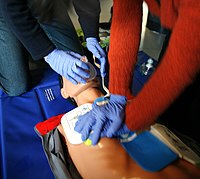
Photo from wikipedia
IntroductionDuring military missions medical care is provided to military personnel as well as civilians. Although cardiopulmonary resuscitation (CPR) may not be a common task in a military field hospital, all… Click to show full abstract
IntroductionDuring military missions medical care is provided to military personnel as well as civilians. Although cardiopulmonary resuscitation (CPR) may not be a common task in a military field hospital, all personnel need to be trained to deal with cardiac arrest.MethodsThis study was a comparative simulation study. Participants (n=36) from the Swedish armed forces performed CPR for 2 minutes at one of three different locations: at ground level, a military bed, or a transportable military stretcher. Compression depth and rate after 2 minutes of CPR and at the time of the participants’ own request to be relieved were measured. Descriptive and inferential analysis was conducted. ResultsThere is a direct correlation between compression depth and working level, concluding that the higher working level, the lower the compression depth. There is in total an overall low percentage of participants within limits for correctly conducted CPR regarding both compression depth and rate. Time to fatigue is related to working level, where increased level results in early fatigue. ConclusionThe quality of CPR is affected by the level at which it is performed. The quality of CPR was satisfactory when working at ground level, but suboptimal when working at hospital bed level or military stretcher level. When working at raised levels, participants appeared to misjudge their own compression depth and rate. This may indicate that changes are needed when CPR is practised in the military hospital setting. Future studies regarding the use footstools are required due to the height of military beds and transportable stretchers.
Journal Title: Australasian Journal of Paramedicine
Year Published: 2019
Link to full text (if available)
Share on Social Media: Sign Up to like & get
recommendations!